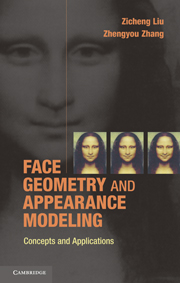2 - Shape models
from PART I - FACE REPRESENTATIONS
Published online by Cambridge University Press: 01 June 2011
Summary
This chapter describes various geometric representations which are commonly used in face modeling. Triangular meshes and parametric surfaces are popular geometric representations for general shape modeling. Linear space representations are particularly useful for faces because people's faces have similar topology, and there are semantically meaningful point-to-point correspondences between different people's faces. One main advantage of the linear space representation is that it greatly reduces the dimensionality (i.e., the degree of freedom). Given a set of example face meshes, one can use Principal Component Analysis to obtain the basis of the face space. This chapter also describes bilinear models, which are used for representing the space of facial expressions of different people. As an extension to the linear representation, the principal components of a bilinear model can be obtained through bilinear singular value decomposition.
Mesh
Triangular mesh is the most common geometric representation for face shapes. A triangular mesh consists of a set of vertices and a set of triangles. The triangles define how the vertices are connected to form the surface. The connectivity of the vertices is also called the topology of the mesh.
Figure 2.1 shows an example of a triangular mesh of a face. It has approximately 190 vertices and 310 triangles. Its vertex coordinates are defined with respect to a coordinate system, called model coordinate system. For example, one can choose to place the origin of the coordinate system somewhere behind the nose.
- Type
- Chapter
- Information
- Face Geometry and Appearance ModelingConcepts and Applications, pp. 19 - 30Publisher: Cambridge University PressPrint publication year: 2011



